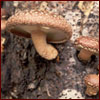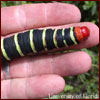The Neighborhood Gardener – February
Happy gardening!
Growing Shiitake Mushrooms
 You can grow shiitake mushrooms in your own garden by following a few simple tips. First, find a good hardwood log about 4 feet in length. You can inoculate the logs by drilling holes and inserting mushroom spawn. It typically takes six to eighteen months after this for the fungus to become established enough to start sprouting mushrooms. More
You can grow shiitake mushrooms in your own garden by following a few simple tips. First, find a good hardwood log about 4 feet in length. You can inoculate the logs by drilling holes and inserting mushroom spawn. It typically takes six to eighteen months after this for the fungus to become established enough to start sprouting mushrooms. More
The Florida School Garden Competition is Back!
Encourage teachers and volunteers to submit an application on behalf of their school garden to the 2012 Florida School Garden Competition. Entries are due March 8. Last year's winner for the entire school garden division was the Orlando Junior Academy. Their "Schoolyard Garden" had four themed areas: a vegetable garden, a pollinator garden, a native garden, and a small citrus grove. Read more about the winners from last year and see their complete award-winning packets.
Plant of the Month: Japanese Magnolia
 Sometimes called saucer magnolia, Japanese magnolia is a deciduous ornamental tree with white, yelow, pink, or purple flowers. The flowers appear before the tree starts leafing out, which is part of what makes the display so striking. These small- to medium-sized trees can be a good choice for many of today’s smaller yards. Japanese magnolia can be successfully planted in North and North Central Florida. More
Sometimes called saucer magnolia, Japanese magnolia is a deciduous ornamental tree with white, yelow, pink, or purple flowers. The flowers appear before the tree starts leafing out, which is part of what makes the display so striking. These small- to medium-sized trees can be a good choice for many of today’s smaller yards. Japanese magnolia can be successfully planted in North and North Central Florida. More
February in Your Garden
Replenish tired flowerbeds with cool-weather annuals for a bright display that will last until the heat arrives in early summer. Choices include snapdragons, dianthus, nemesias, diascias, sweet alyssums, petunias, or calibrachoas. Before new growth emerges on ornamental grasses, trim brown or damaged leaves.
For more month-by-month gardening tips, check out the Florida Gardening Calendar. Three different editions of the calendar provide specific tips for each of Florida's gardening regions—North, Central, and South. More
Friend or Foe? Foe: Frangipani Hornworm
 While the tetrio sphinx moth is a drab gray color, its larval form is a large, brightly colored caterpillar, called a frangipani hornworm. This pest feeds on frangipani, or plumeria, trees in South Florida. Eating up to three leaves a day, it can quickly defoliate a tree. Hand-picking larvae is probably the best way to eliminate frangipani hornworms from trees. More
While the tetrio sphinx moth is a drab gray color, its larval form is a large, brightly colored caterpillar, called a frangipani hornworm. This pest feeds on frangipani, or plumeria, trees in South Florida. Eating up to three leaves a day, it can quickly defoliate a tree. Hand-picking larvae is probably the best way to eliminate frangipani hornworms from trees. More
Featured Shows on Gardening in a Minute
Success Stories
- We're looking for inspiring, Florida-Friendly success stories from your county. Submit yours today to Wendy Wilber.





